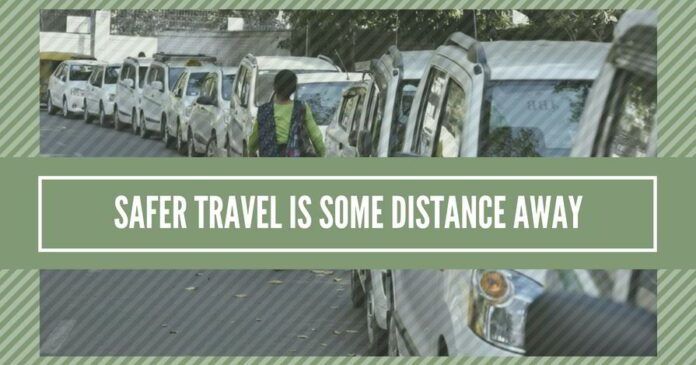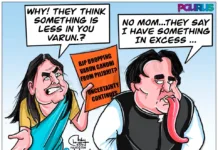
The exercise of making travel safer for commuters, especially women is well intended, but its translation into desired results is predicated upon solid, concerted action.
The safety measures concerning the safety of women commuters availing of cab services resulted in the new Taxi Policy Guidelines in April last year. But these are yet to become a reality on the ground primarily because of poor coordination among various authorities and the absorption of technology in public transport.
More than a year ago, Women & Child Development Minister Maneka Gandhi had written to Minister of Road Transport & Highways and Shipping Nitin Gadkari to incorporate the necessary safety measures in the regulatory guidelines being prepared by his Ministry (MoRTH). Her recommendations were triggered by the numerous cases of sexual harassment of women in cabs reported at that time. Many victims had taken to Twitter and Facebook to flag their ordeal.
There may be variation in the response mechanism in different states; it may be police in one state and some other body in another.
The WCD Ministry suggested: the taxis should be mandatorily fitted with GPS panic devices; for the safety of women and child passengers, the central locking system in the taxis should not be allowed; the driver’s identification along with the photo and registration number of the vehicle should also be prominently displayed in the taxi; violation of the stipulated rules by the taxi operators/drivers should be strictly dealt in accordance with law; and sharing of seat should be subject to willingness of passengers.
The MoRTH, however, was not waiting for the WCD Ministry to make its recommendations. In November 2016, it had issued a notification stipulating that all public service vehicles, (except two and three wheelers, e-rickshaws) have to be equipped or fitted with vehicle location tracking devices and one or more emergency buttons. The devices and emergency buttons were supposed to be fitted by manufacturers, dealers, or operators. The deadline set was March 31, 2018.
It has been missed; now vehicles are supposed to install such devices and buttons by a year—that is, March 31, 2019.
At the heart of the issue are typical problems that plague governance in India. The first and foremost is the proclivity of politicians to promise the moon. The applause that follows is immediate, while the criticism for not delivering on the promise comes later (assuming that people remember it till then).
Second, the pledge was made without taking into account the capacity of the system to bear the burden, which in this case is huge. Millions of vehicles—buses, taxis, et al—are supposed to install the devices and buttons.
Third, all the pros and cons were not deliberated upon. For instance, are the required devices available in such large numbers? If yes, at what cost? Is the software available? What will be the response mechanism? There has been little clarity on such crucial aspects.
An official in the Ministry of Electronics & Information Technology told this correspondent that the Centre for Development of Advanced Computing (C-Dac) has prepared software for the purpose. But this happened a few weeks ago. “From August, we’ll start using it in vehicles,” he added.
Which means that when Gadkari’s Ministry brought the notification, C-Dac had perhaps started work on the software.
MoRTH officials said that the back-end or response system is not ready as yet. Further, they added, there may be variation in the response mechanism in different states; it may be police in one state and some other body in another.
There seems to be little communication with states, which will play the most important role in this endeavor.
The MoRTH, after consultation with experts and stakeholders, has mandated a technical specification, AIS-140, for all GPS equipment. Technical agencies have been impaneled to approve the equipment, MoRTH officials said, adding that the process got completed in February-March this year. Only after this, production of devices can start.
Meanwhile, there seems to be little communication with states, which will play the most important role in this endeavour, over the subject. In Indore, the association of the ICSE schools of Indore got a stay from the Indore Bench of High Court following the extension of the deadline by the MoRTH. Kerala had engaged C-Dac to prepare the system; it also heaved a sigh of relief when the deadline was extended.
Goa, however, had called bids for the supply, installation, and maintenance of digital fare meters with the printer, GPS device, and panic button. The bids opened on April 30 and are likely to be finalized by the end of June.
An industry insider told this correspondent that the Goa government had made no distinction between 2G, 3G, and 4G devices. Since 2G devices would be cheaper for the vendors to provide, they would opt for these devices only. This would defeat the purpose because the 2G network is very poor and the system will face regular breakdowns, he said.
Goa Transport Director Nikhil Desai, however, refuted this viewpoint, saying, “As of now we are satisfied with the ongoing process and there is no reason to be alarmed. Only persons who seem to be losing their sleep on this issue are the bidders who have lost out in this bid.”
The fact, however, is that the entire process of making travel safer for commuters, especially for women, is yet to take off. The exercise is indeed well intended, but the translation of good intentions into desired results is predicated upon solid, concerted action. That, sadly, is missing.
Note:
1. The views expressed here are those of the author and do not necessarily represent or reflect the views of PGurus.
- Liberty Is Penalized, Violence Goes Untouched - December 21, 2019
- Rahul’s Howdy bloomer - September 22, 2019
- Chidambaram’s hypocrisy - August 22, 2019






Some simple but effective steps are enough to guarantee safe travel for all including women.
1.Only yellow board cars can be used as taxis.They should have distinct colour and a lighted Taxi board at the roof
2.Only registered drivers with uniform can drive these taxis.Their name/registration number and photo to be displayed prominently for passengers to see
3.All drivers need to pass thro’ police verification.Police should also educate them on safe driving practices,do’s/don’ts while engaging passengers.
4.All drivers need to enter in the police website their name,registration no,vehicle no,time they start work and time they shut down//every time they operate taxis
5.Passengers should have a single number manned by police 24hrs/7days a week which passengers can use in times of distress
6.Punishment should be swift and brutal especially in case of physical assault.All crooked drivers should have their license cancelled.Their punishment should be prominantly displayed to the notice of all drivers.Naming and shaming is a vital aspect of minimising bad behaviour.
Most of the problems are due to poor laws,poor application of laws especially police and lack of system.Western countries taxi drivers also have itchy fingers but the law comes down so heavily on them their nuts gets nugged brutally if they misbehave.Here these jokers are let loose on public without a concern on safety and then start to holler when bad things happen.